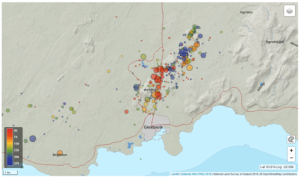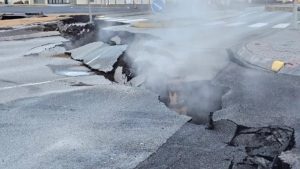
One of the daily activities that is helping me stay sane is volcano watching. I love volcanoes. I especially enjoy when they erupt in places that have webcams but don’t affect the lives of people. Unfortunately, those are both rare, unless, it seems, you are in Iceland.
Over the past decade, Iceland has given us hours of entertainment watching lava flow out from rifts and cones. People gather nearby to watch, set up webcams for science, and even fly drones to catch amazing imagery that they then share with the world at large. And as long as no one gets hurt, that’s fine.
But volcanoes aren’t always polite. In fact, they usually are not polite. They erupt where people live, partially because we keep building near them for the rich soil. They erupt in backyards. They destroy towns. And when your home is on a volcanic island created by both a hot spot and the Mid-Atlantic Ridge, there’s always a risk that magma will find its way up through the rocks under you.

Such seems to be the case with the town of Grindavik in the southwest of Iceland. For weeks now, scientists have been collecting data on earthquake swarms and ground deformation around and under and within the town. Thousands of earthquakes have shaken the region since October 25, marking a magmatic intrusion about 3 to 3.5 kilometers below the surface. Measured subsidence on the west side of Grindavik has been on the order of 1.5 meters, while the uplift caused by the dike’s emplacement to the northeast of the town has continued at a steady rate. Additionally, instruments in the area are measuring elevated areas of sulfur dioxide, a potential sign of magma getting ready to breach the surface.
On November 10, the entire town was evacuated, displacing nearly 4,000 people and their animals, including pets and livestock. Drone footage has shown a large crack forming in the city, and steam from the broken water pipes below ground has been escaping. From our own analysis of the footage, we have determined that the local sports complex, several houses, a church, and a Norse shrine have sustained visible damage along the rift.

And yet, as of recording, no magma has breached the surface anywhere near the town. Of course, now weather conditions are impacting everyone’s ability to monitor the situation, with wind, fog, and even snow wreaking havoc on the webcams and instruments. Officials continue to state that “an eruption can happen at any time”, and residents are still trying to claim personal items from their homes as the evacuation appears to have no end in sight. The Blue Lagoon – a massive hot springs tourist attraction – has been closed until at least the end of November. The nearby geothermal plant has sustained damage in the quakes.
Still we wait.
So how did this happen? Was Grindavik built knowingly over a volcano? Are we heading for a Tommy Lee Jones / Anne Heche situation? (And did anyone have “Volcano the movie IRL” on their 2023 bingo card?)
Again, Iceland is a volcanic island. There are 32 known active volcanoes in the tiny country. Beneath the island is a mantle plume, or hot spot, that is welling up molten rock that feeds the volcanoes. The island also rests atop the Mid-Atlantic Ridge, where the North American Plate and the Eurasian Plate are moving away from each other. This movement causes the crust along the ridge to thin, allowing more molten rock to rise up through the crust, creating new land as that lava cools underwater.
That means that the entire island has potential volcanic hazards pretty much everywhere. But that doesn’t mean every place is as likely to erupt as every other place. Grindavik was built on lava flows that are almost 2500 years old today. When Viking settlers founded the town in 934, that lava flow was old, stable, and weathered. No reason to believe that a volcanic eruption was anywhere in the near future. Or even, apparently, in the distant future.
And so a tiny fishing community was founded, and in the twentieth century, grew to be the small coastal town of Grindavik. Tourists come to the Blue Lagoon all year. There’s even a bridge crossing a rift valley, connecting the two tectonic plates.
Now here we are, more than a millennia since the town was founded, faced with the potential destruction of the entire city. Sure, rifts have happened before, and the town simply paved them over. With this new activity, the rift in town may become the rift where the magma breaks through, and similar to another eruption elsewhere in Iceland in the 1970s, Grindavik will end up covered in lava and ash. Or the eruption happens to the north, and the lava flow makes its way downhill to town anyway.
Which, honestly, either of those means we do need Tommy Lee Jones to come to the rescue. What even is this decade?
On the other hand, the magma could manage to not break the surface at all.
I’m still rooting for a volcano, but without any loss of life, please.

Iceland isn’t the only place with active volcanoes. It’s not even the only place with active volcanoes Right Now. In the last few weeks, the news has also covered eruptions at Mt. Etna in Italy, Mayon in the Philippines, Popocatépetl in Mexico, and the Kamchatka Peninsula in Russia. You are probably not alone if you are feeling like there has been an uptick in volcanic activity around the world.
However, it’s an illusion.
According to the USGS, there are “on average between 50 and 60 volcanoes that erupt each year somewhere on Earth (about 1 every week)”, and while some of these eruptions may coincidentally occur within hours of each other, there is no relation between them. The Earth is too vast for an eruption in Russia to trigger an eruption in South America, and particularly around the Ring of Fire in the Pacific Ocean, volcanoes erupt all the time.
The plates, they are a’movin.
On top of all of that, chemical analyses of lava flows from different volcanoes show different compositions. For example, two currently active Hawaiian volcanoes, Mauna Loa and Kilauea, are only 33 kilometers apart from one another but originate from completely separate magma reservoirs with different chemistry.
That’s not to say that volcanoes in a small area cannot be related. The volcanoes of an island arc are all basically from the same magma source – the subduction of a downward-moving plate causes rocks to melt at lower temperatures thanks to the influx of water. If a magma source spreads out due to the type of rock near the surface being easier to melt (or just being a very large emplacement), lava may erupt from multiple places in a volcanic field.
So just because it seems like Mother Earth is angry at us and causing volcanoes to go off at a higher-than-normal rate, it’s not true.
Friendly reminder that correlation is not causation.
